Related Research Articles
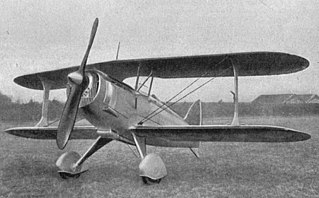
The Blériot SPAD S.510 was a French single-seat, single-engined biplane fighter aircraft. First flying in 1933, 60 were built for the Armée de l'Air, entering service in 1936. The type remained in service as a fighter-trainer at the start of the Second World War. It was the last French biplane fighter to enter production.

Morane-Saulnier MoS-50 was a French parasol configuration trainer aircraft built in 1924. The twin-seat aircraft was of wooden construction and was one of the last aircraft to have a rotary engine, a 97 kW (130 hp) Clerget 9B.

The Morane-Saulnier M.S.225 was a French fighter aircraft of the 1930s. It was produced in limited quantities to be used as a transitional aircraft between the last of the biplanes and the first monoplane fighters.

The Morane-Saulnier MS.230 aircraft was the main elementary trainer for the French Armée de l'Air throughout the 1930s. Almost all French pilots flying for the Armée de l'Air at the outbreak of World War II had had their earliest flight training in this machine. It was the equivalent of the Stearman trainer in the United States air services and the de Havilland Tiger Moth in the British Royal Air Force.
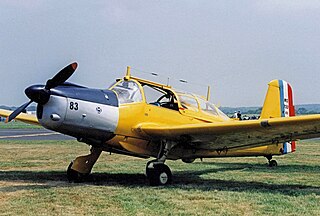
The Morane-Saulnier Alcyon is a two or three-seat basic training monoplane designed and built in France by Morane-Saulnier.

The Morane-Saulnier Vanneau is a two-seat basic trainer built in France by Morane-Saulnier and ordered by the French Air Force.

The Morane-Saulnier MoS-121, also known as the Morane-Saulnier MS.121 was a French fighter prototype of the 1920s. It was Morane-Saulnier's first fighter design after World War I.

The Letord Let.5 was probably the most numerous of a family of 3-seat reconnaissance bombers, designed and built in France from 1916, originally to an A3 specification from the STAé.
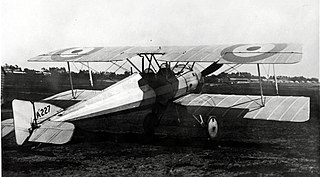
The Morane-Saulnier BB was a military observation aircraft produced in France during World War I for use by Britain's Royal Flying Corps. It was a conventional single-bay biplane design with seating for the pilot and observer in tandem, open cockpits. The original order called for 150 aircraft powered by 110-hp Le Rhône 9J rotary engines, but shortages meant that most of the 94 aircraft eventually built were delivered with 80 hp Le Rhône 9C rotaries instead. A water-cooled Hispano-Suiza 8A engine was trialled as an alternative in the Type BH, but this remained experimental only. A production licence was sold to the Spanish company Compañía Española de Construcciones Aeronáuticas (CECA), which built twelve fitted with Hispano-Suiza engines in 1916.

The Morane-Saulnier MS.129 and its derivatives in the MS.130 series were a family of military trainer aircraft produced in France in the 1920s. They were conventional, parasol-wing monoplanes with open cockpits in tandem and fixed tailskid undercarriage. The initial version, the MS.129, was produced in small numbers for the Romanian Air Force and civil users, but the major production version was the MS.130, which equipped the French Navy and a number of foreign air arms.

The Morane-Saulnier MS.147 and its derivatives, the MS.148 and MS.149 were a family of trainer aircraft produced in France in the late 1920s for civil and military use. They were derived from other machines in Morane-Saulnier's successful line of monoplane trainers, combining the wire-braced parasol wing of the MS.138 with the fuselage and undercarriage of the MS.130.

The Morane-Saulnier M.S.325 was a French Air Force fighter aircraft built by Morane-Saulnier in 1933 to meet the requirements of 1930 fighter aircraft specification. The design was unsuccessful and was abandoned in 1934.
The Stampe et Vertongen RSV.22 was a training biplane produced in Belgium in the 1920s.
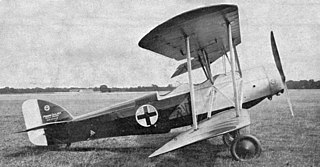
The Morane-Saulnier MS.140 was designed in France as an ambulance aircraft with the ability to operate from small fields and which could double as a trainer. Only one of these single engine, wooden biplanes was built, first flying about 1927.
The Morane-Saulnier S,also known as MoS-10, was a large twin-engined biplane bomber designed and built in France around 1916. Powered by two 250 hp (190 kW) Renault 12E V-12 water-cooled piston engines, with Hazet type side radiators, the 'S' was given the STAé designation MoS-10 and serial MS-625.

The Morane-Saulnier MS.350 was a French aerobatic trainer flown in 1936. Only one was built but it had a long career, flying post-war until the 1960s.
The Morane-Saulnier MS.300 and MS.301 were French parasol wing introductory trainer aircraft, first flown in 1930. They differed only in engine type. Neither reached production but were developed into two similar trainers, the MS.230 and MS.315, which were made in large numbers.
The Morane-Saulnier MS.152 was a French multi-purpose aircraft built in 1928. It did not go into production.
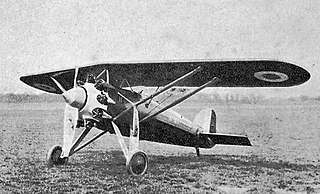
The Morane-Saulnier MS.224 was a prototype fighter plane built by Morane-Saulnier in the early 1930s.
The Morane-Saulnier MS.250 was a crew-trainer aircraft built by Morane-Saulnier in the late 1920s.
References
- ↑ Serreyer, J. (28 August 1923). "L'Avion-Ecole Morane-Saulnier". Les Ailes (106): 2.
- ↑ Bruno Parmentier (17 May 2003). "Morane-Saulnier MoS-43" . Retrieved 28 December 2016.